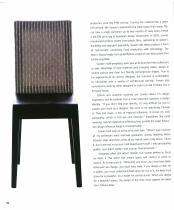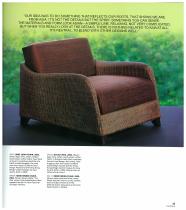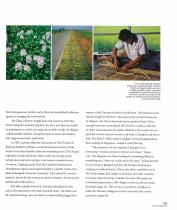 Website:
Yothaka
Website:
Yothaka
Catalog excerpts

A SENSE OF LEELA Suwan Kongkhunthian's particular mix of life experience has helped him become the most influential of Bangkok's furniture designers, known for his stylistic mastery and for consistently breaking new ground. He grew up amid the temples, teak houses and craftspeople of Chiang Mai, which helped him understand the inner logic of local architecture and design. And as one of the first Thais to practise interior design overseas, he gained an international perspective from a decade working in Singapore. Suwan focused on furniture ahead of other Thai designers. For his under-...
Open the catalog to page 2
aristocracy since the 19th century. Turning this material into a piece of furniture, like Suwan's award-winning Dalai Lipao chair (page 36), can take a single craftsman up to two months of daily work, hence a €4,500 price tag in European design showrooms. In 2005, Suwan introduced furniture woven from plastic fibre, capitalising on plastic's durability and resurgent popularity. Suwan calls these products a form of 'technocrat', combining hand production with technology. The fibre is factory-made from polyethylene, a type of non-toxic plastic that Suwan's style progresses each year as he...
Open the catalog to page 3
"OUR IDEA WAS TO DO SOMETHING THAT REFLECTS OUR ROOTS, THAT SHOWS WE ARE FROM ASIA. IT'S NOT THE DETAILS BUT THE SPIRIT, SOMETHING YOU CAN SENSE. THE MATERIALS AND FORM LOOK ASIAN—A SIMPLE LINE, RELAXING, NOT VERY COMPLICATED BUT WHEN YOU REALLY LOOK AT THE DETAILS, THERE IS NOTHING RELATED TO ASIA AT ALL. IT'S NEUTRAL, TO BLEND WITH OTHER DESIGNS WELL." ABOVE LORIS LIPAO CHAIR, 2002. Woven lipao vine, rattan, timber, hand-woven cotton fabric. Seen here at Suwan's workshop amid the rice fields outside Bangkok, the Loris chair won Japan's G-Mark Good Design Award and the Hong Kong Design...
Open the catalog to page 4
Water Hyacinth Crafting a Thai Solution to Colonial Weeds Historians are apt to note Thailand's legacy of resisting conquest. The nation was the only one in South-east Asia that eluded Western colonisation, thanks in part to deft diplomacy. Yet Thailand did suffer one foreign invasion that continues to this day. Starting from a toehold in the 19th century, the interloper gained a chokehold on the lifeblood of Siamese agriculture, transport and commerce—the kingdom's myriad inland waterways. Eichhornia crassipes, the floating plant known as water hyacinth, still menaces canals, rivers and...
Open the catalog to page 7
A non-native species, floating Eichhornia crassipes brought Thailand little but clogged waterways until a 1980s research project innovated methods for turning the weed into furniture. (Drawing courtesy of the Center for Aquatic and Invasive Plants, fatal consequences. Further south, Mexicans brandished bulldozers against it, ravaging the environment. The Thais, however, fought back with creativity. First they tried turning the weed into pig feed. But for a pest that can double its population in a week, even pigs eat too little to help. So villagers crafted another solution: drying the stems...
Open the catalog to page 8
Their firms consume more than 8,000 kilometres of water hyacinth braid a year—enough to stretch from their workshop to Paris. Thousands more kilometres are used by another dozen smaller firms that have followed their lead. Good riddance to the weeds, which are actually becoming scarce in some areas. That makes water hyacinth crafts doubly green. They're infinitely renewable, and no harmful chemicals are used to process the plant—just a food preservative that prevents mould. Water hyacinth has become popular thanks to its special qualities. Because the stems are thick, the braid is wide,...
Open the catalog to page 9
OPPOSITE: ML Pawinee Santisiri has innovated an ample portfolio of techniques for weaving water hyacinth stems into decorative THIS PAGE: The fibre gives furnishings a warm, rustic feel different from other woven materials, as seen in Suwan Kongkhunthian's Gancha lounge chair for Yothaka (2001) designed by Paiwate Wangbon stalks—freshly harvested water hyacinth. After a few days in the sun, the stalks turn golden brown like rice crackers, now ready The farm families who braid stems here can earn a better living right at home without resorting to jobs in the congested city, just as the...
Open the catalog to page 10
